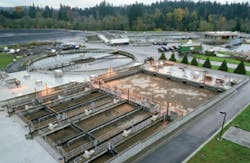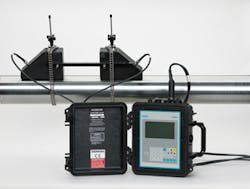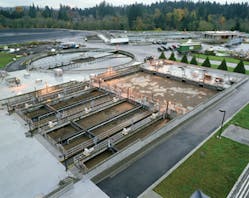Wastewater treatment plants play an important role in every community. They ensure the sewage produced by homes, businesses and industrial facilities does not harm the population or the environment. However, the very same treatment plants designed to protect communities can cause significant and long-lasting damage if their ability to measure wastewater flow is compromised. Subsequently, these plants can find themselves afoul of the law if they violate strict regulations put in place to safeguard the nation’s water.
A municipal wastewater treatment facility in the state of Louisiana was experiencing such an issue. There were numerous problems with the facility’s existing measurement instrumentation that prevented it from maintaining an accurate effluent flow signal. The facility needed to find a more reliable way of monitoring flow in order to make certain they were complying with state and federal environmental policies. The most cost-effective solution — installing a new clamp-on ultrasonic flowmeter.
The process of treating wastewater
Wastewater originates from a number of residential, commercial and industrial sources and can be comprised of a wide variety of substances including human and animal waste, food particles, soil and other sediments, oil, grease, soaps, and chemicals. Due to the presence of so many pollutants, wastewater often carries with it a host of potentially destructive bacteria, viruses and parasites.
Municipal wastewater treatment plants like the one in Louisiana collect wastewater from homes served by a public sewer, transport it to the plant via pipes and pump stations, and then remove a significant portion of the pollutants before the remaining liquid (known as effluent) re-enters a body of water or is reused. This process of treating wastewater generally occurs in several stages:
Preliminary treatment. Larger-sized debris (e.g. sticks, sand and gravel) that could potentially damage plant equipment is removed and disposed of.
Primary treatment. Wastewater is held in a still basin so that heavy solids can settle to the bottom while oil, grease and other lighter solids float to the top. The solids from the bottom and top, collectively referred to as sludge, are further treated to stabilize them and reduce strong odors.
Secondary treatment. The liquid that remains following the primary treatment process is subjected to microorganisms, which remove dissolved and suspended organic matter by absorbing it as their food supply. A separation process may then be required to remove these microorganisms from the wastewater.
Tertiary or final treatment. Wastewater is disinfected with chlorine or ultraviolet light to remove disease-causing organisms. A chlorine-neutralizing chemical may then be added to the clarified wastewater before it is discharged.
Advanced treatment. In some cases, further chemical treatment may be required to remove nutrients such as phosphorus and nitrogen.
Protecting humans & ecosystems
Improperly treated wastewater can threaten the health of humans and entire ecosystems. In humans, wastewater can cause such diseases as gastroenteritis, encephalitis, hepatitis, cholera, dysentery and typhoid fever, and can lead to restrictions on drinking water, shellfish consumption, beach usage, and recreational activities like fishing and swimming. When discharged, wastewater can also kill off fish and other aquatic organisms.
It is for all of these reasons that the United States Congress adopted the Clean Water Act in 1972 as the primary federal law governing water pollution. The Clean Water Act expanded upon the Federal Water Pollution Control Act of 1948 by establishing a basis for the regulation of wastewater discharge into U.S. waters. The act introduced the National Pollutant Discharge Elimination System (NPDES), through which it became illegal for industrial buildings, municipal governments, and certain agricultural facilities to dump pollutants into navigable waters without a permit.
Although the U.S. Environmental Protection Agency (EPA) manages the NPDES program, 46 states are currently authorized to issue permits directly to facilities that discharge effluent into bodies of water. Individual states are responsible for setting and enforcing limits on how much wastewater each facility can receive and discharge, as well as on the concentration of pollutants within the effluent.
Effective monitoring requires accurate measurement
In order to meet these stringent regulations and protect the bodies of water receiving the effluent flow, wastewater treatment facilities must be fastidiously managed. Not only must plant operators receive thorough training in order to fully understand the requirements of the permit program, they must also carefully oversee the entire decontamination process—from measuring the intake of wastewater, to carefully observing each step of treatment and making adjustments wherever necessary, to ensuring that only lawful amounts of effluent are being discharged from the plant.
Because effective monitoring requires a precise and reliable way to measure wastewater flow, the Louisiana facility had chosen a clamp-on ultrasonic flowmeter. These meters can perform accurate measurement under even the most challenging conditions and can be used to measure both homogeneous liquids and those containing extensive suspended solids or aeration. Their exceptional versatility makes these meters ideal for the wastewater industry, as they are capable of handling the diverse range of fluids processed by wastewater treatment plants (including raw sewage, sludge, chemical additives, and effluent).
In addition, clamp-on flowmeters can save a plant both time and money, as they do not require the pipe to be cut or the flow to be stopped. They also minimize maintenance expenses since the sensors are mounted on the outside of the pipe, preventing deposits from forming.
A new solution
Unfortunately, the clamp-on ultrasonic flowmeter being used at the Louisiana treatment plant had experienced a number of electronics failures, and the plant manager was having difficulty obtaining spare parts. In considering the prospect of purchasing a new meter, the manager required minimal interruption to the effluent flow because it would interfere with reporting to the local Department of Environmental Quality. He also wanted assurance that spare parts and factory support would be guaranteed for at least five years.
A Sitrans FUP1010 clamp-on ultrasonic flowmeter from Siemens (www.siemens.com/flow) was brought on site and installed within a few hours. This particular meter features battery power for portable field use, which means that it is transportable from one installation to another and is a good fit for conducting performance and verification checks. It is also capable of switching between WideBeam transit time and Doppler mode, eliminating the need to change meters when aeration and solids vary.
Following installation of the new clamp-on flowmeter, the effluent flow signal was restored almost immediately. With the help of this technology, the Louisiana treatment plant was once again brought into compliance.
A clean water solution
Without clean water, populations cannot thrive and communities cannot sustain themselves. This is why many governments have made it a priority to protect valuable water resources by regulating the amount of effluent produced by wastewater treatment plants. To remain in compliance with these often-rigorous laws, treatment plants must have access to reliable measurement technology so that they can accurately measure the flow of wastewater through their pipes. Clamp-on ultrasonic flowmeters have proven very useful for this purpose — time and time again.
Scott Stein is currently Division Manager for the John H. Carter Water and Wastewater Division at Breard Gardner in Louisiana, where he supervises technicians as well as performing field startup and training for Chemical Feed Systems and instrumentation for the water and wastewater industry. He holds a B.S. in Environmental Management Systems from Louisiana State University. Stein can be reached at [email protected].




